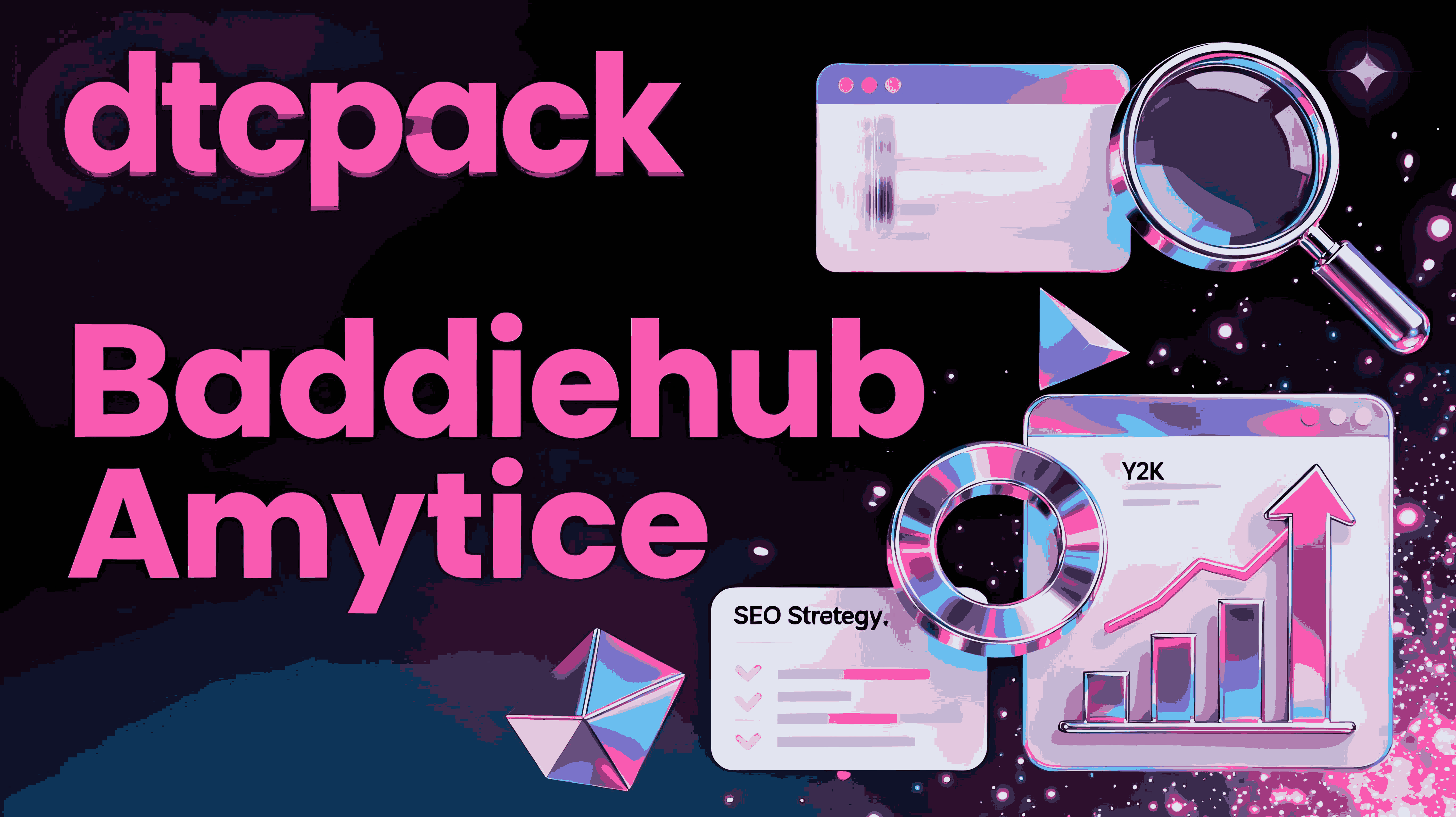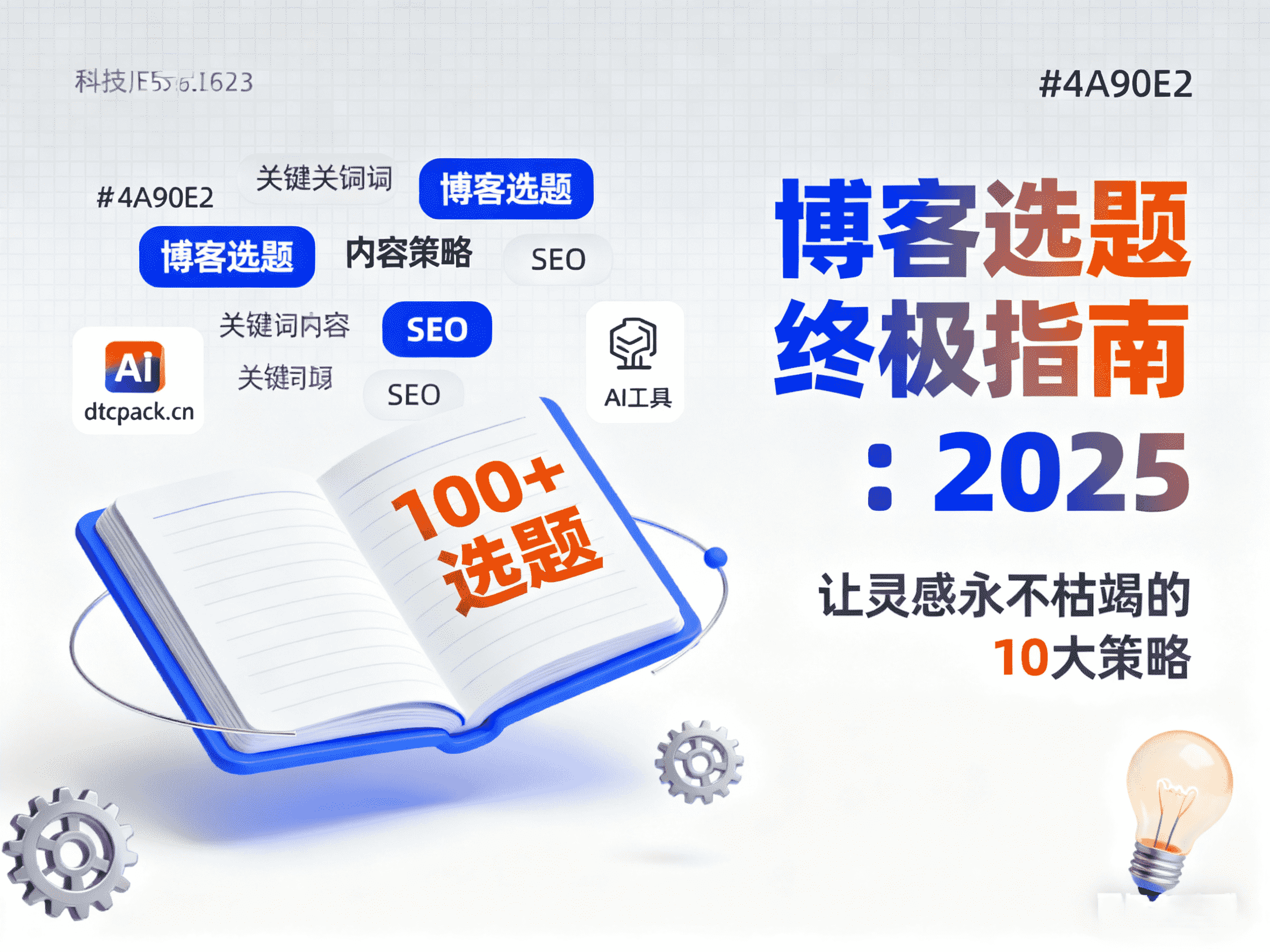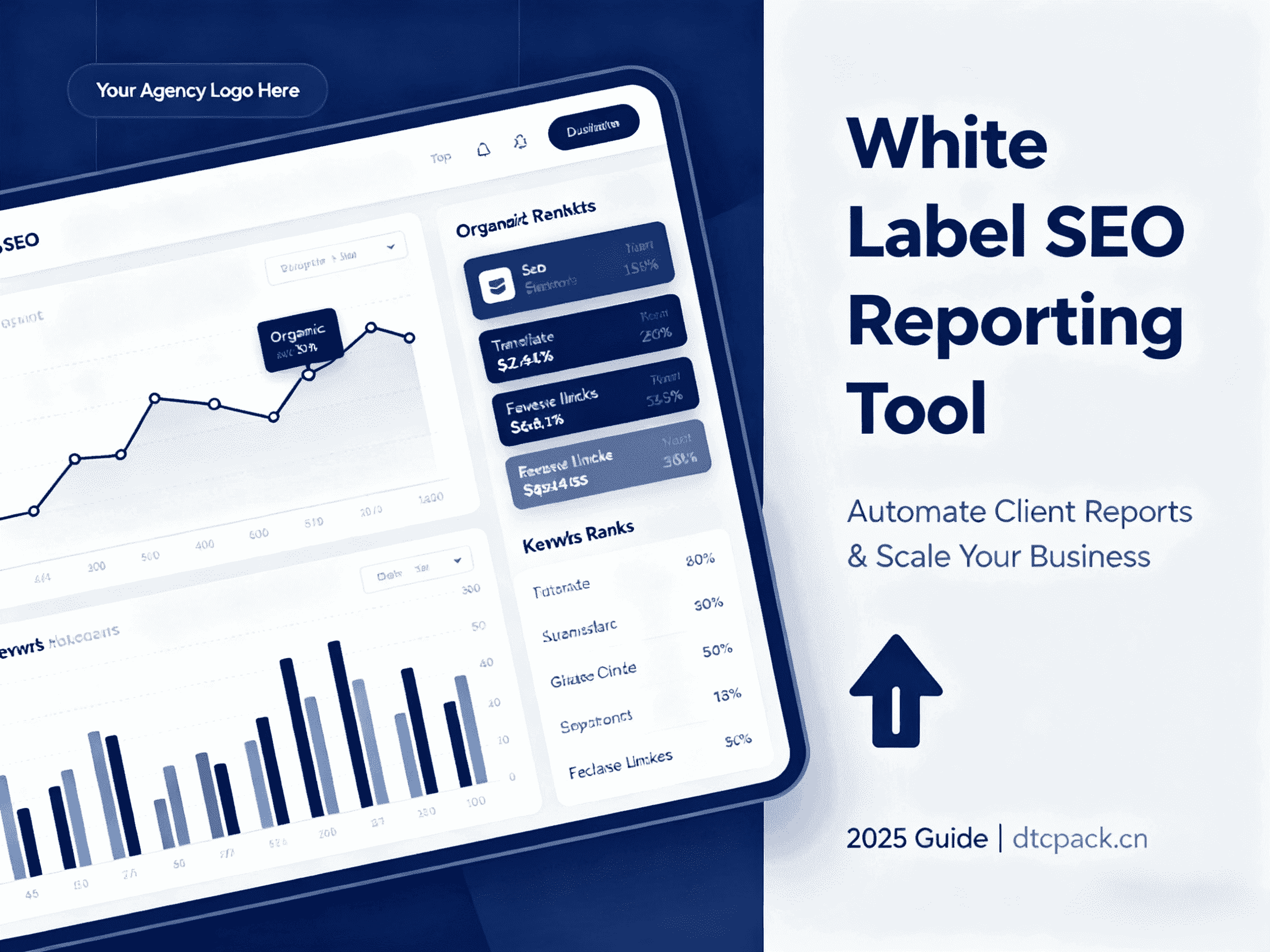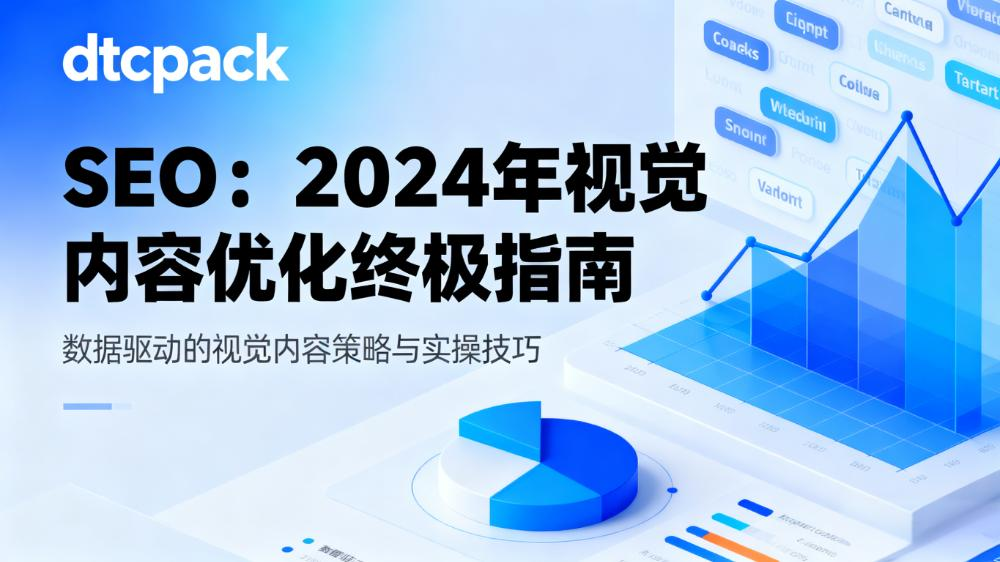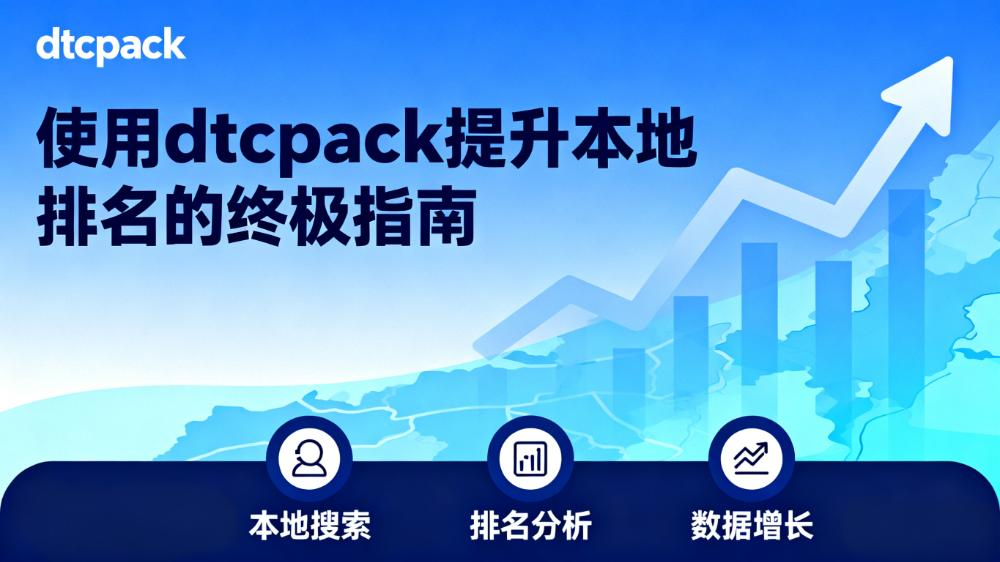What is SEO?
SEO, short for Search Engine Optimization, is the process of improving your website to enhance its visibility on search engines like Google, Bing, and others when people search for relevant content, thereby driving more organic traffic. SEO involves understanding the needs of your audience as well as the technical aspects of configuring your website. It requires optimizing the website’s technical setup, creating high-quality and relevant content, and delivering the best user experience to achieve higher rankings on search engines and attract more organic traffic.
How Does SEO Work?
To understand how SEO works, it’s essential to have a basic understanding of how search engines operate.
Search engines work in three steps: crawling, indexing, and ranking.
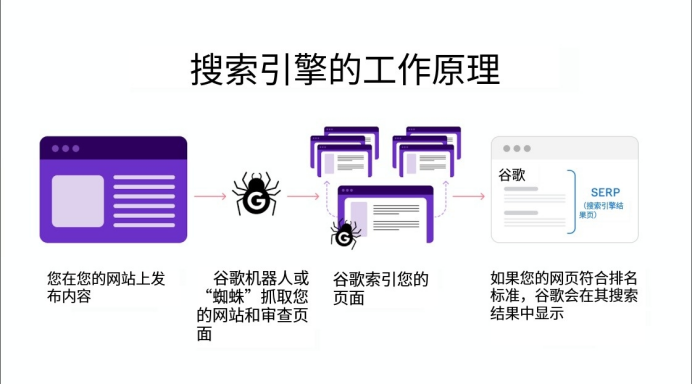
Step 1: Search Engine Crawling
The first step is crawling. Search engines send web crawlers to discover new pages and record information about them. These web crawlers are sometimes referred to as "spiders," "bots," or "Googlebot." Their goal is to find new web pages and regularly check previously visited pages to see if they have been updated or changed.
Search engines crawl web pages by following links they’ve already discovered. For example, if you have a blog and link to it from your homepage, when a search engine crawls your homepage, it will look for other links and may follow them to reach your new blog post.
Step 2: Search Engine Indexing
The second step is indexing. Indexing is when a search engine decides whether to use the content it has crawled. If the search engine deems the crawled page valuable, it will add it to its index.
The index is used in the final ranking stage. When a web page or content is indexed, it is archived and stored in a database, where it can be retrieved later. Most pages that provide unique and valuable content are added to the index. A page may not be indexed if:
- The content is considered duplicate.
- The content is deemed low-value or spam.
- The page cannot be crawled.
- The page lacks inbound links.
Pro Tip: You can check indexed pages by typing "site:yourdomain.com" into the search bar (see the example below). This will show you the pages indexed by Google. For a more detailed report, you can view the "Index Coverage Report" in Google Search Console.

Step 3: Search Engine Ranking
The third and most crucial step is ranking. Ranking can only occur after the crawling and indexing steps are complete. Once a search engine has crawled and indexed your website, your site becomes eligible to rank.
Search engines use over 200 ranking signals to sort and rank content, all of which fall under the three pillars of SEO: technical optimization, on-page optimization, and off-page optimization.
Some examples of signals search engines use to rank web pages include:
- Keywords in the Title Tag: Whether the keyword or its synonyms are mentioned on the page and within the title tag.
- Loading Speed: Whether the page loads quickly and is mobile-friendly.
- Site Authority: Whether the page and website are considered authoritative on the searched topic.
- Backlinks: The quantity and quality of backlinks pointing to the page.
- Content Quality and Relevance: Whether the content is valuable and relevant to the website’s target audience.
- Mobile-Friendliness: Whether the page, content, and images are optimized for mobile devices.
As a website owner, your job is to help search engines crawl and index all the pages on your site that you want them to. You can ensure pages are crawlable and indexable through various actions and best practices, often referred to as technical SEO.
Note: Google is not the only search engine, but it is by far the most popular. This is why we often refer to Google when discussing search engines. Additionally, the fundamental principles of SEO are very similar across most search engines.
Why is Search Engine Optimization (SEO) Important?
-
Natural Search is a Great Source of Website Traffic
Traffic from natural search is often of high quality because these visitors actively search for specific keywords to land on your website, indicating a clear need or interest in your content. For example, Google Analytics charts can show a website that has invested significantly in natural search traffic, demonstrating its value.
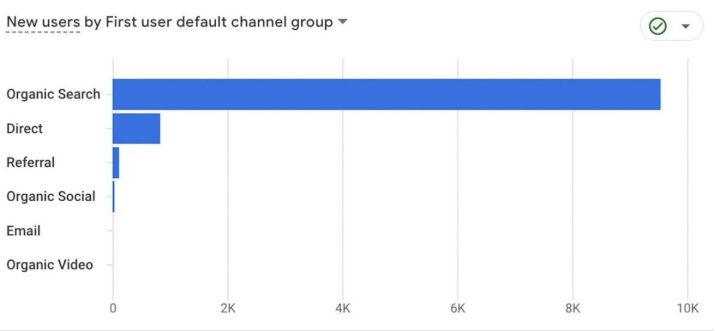
The number of search queries related to your business each day could far exceed the clicks you generate through channels like social media. By focusing on natural search, you have the potential to attract more traffic over time if you can improve your rankings, as there is a clear correlation between high rankings and high click-through rates (as shown in our search status report).

-
SEO is Cost-Effective
Compared to channels like paid social media, search engine optimization is often a more cost-effective way to increase traffic.
Paid acquisition requires significant investment in creative design, copywriting, landing pages, and experimentation. Additionally, you need to pay for the ad placements themselves.
With SEO, you must invest in your website and content creation, but you don’t have to pay for ad placements. Once you start seeing results from SEO, they can continue to deliver benefits even if you stop or reduce spending.
This is not the case with advertising. The chart in the domain overview illustrates the volatility of paid traffic:

Companies that invest in search engine optimization (SEO) tend to maintain or even increase their results over time, even with reduced effort. However, paid channels require continuous advertising spending to remain competitive.
3. SEO complements paid marketing efforts
There is clearly a connection between PPC (Pay-Per-Click) and SEO (Search Engine Optimization).
This could be because you are simply occupying more space on the SERP (Search Engine Results Page).
For example, Monday.com bids on the keyword "CRM for small businesses."
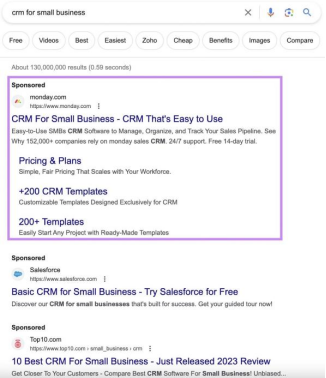
They also rank organically for the same keyword.
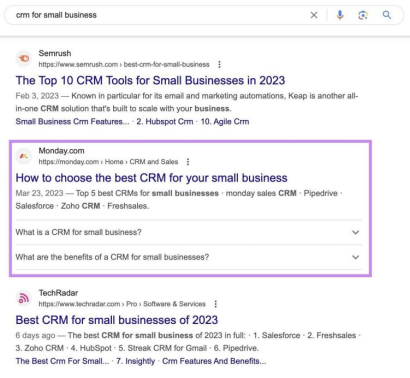
Occupying so much SERP space increases their chances of driving website clicks. The added brand visibility from appearing twice on the same page can also have a positive impact. Due to the mere exposure effect, people tend to prefer things they are familiar with.
4. How SEO Builds Trust, Credibility, and Brand Awareness
One of the core aspects of SEO is creating and optimizing high-quality content. This content addresses users’ questions and solves their pain points, thereby building trust. When users find your content helpful, they are more likely to trust your brand. Appearing in search results often gives the impression that your brand is a trustworthy and reliable source of information.
Think of it this way: The SERP is like a highway, and the ranked pages are essentially billboards. The more searches you appear in, the more brand awareness you build. This brand awareness increases the likelihood that people will choose to do business with you over less-known competitors.
Google also values experience and expertise. These are key components of EEAT (Experience, Expertise, Authority, and Trustworthiness) in Google’s Search Quality Evaluator Guidelines.
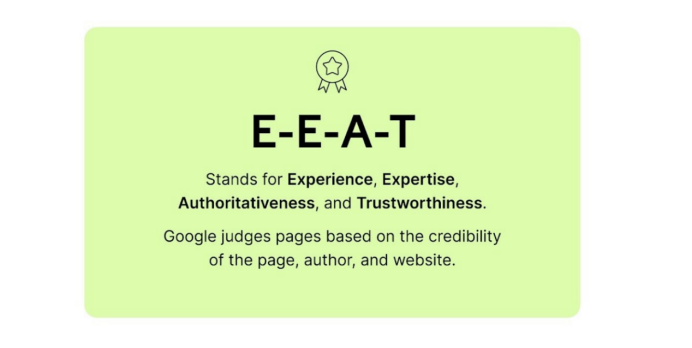
-
SEO Connects You with Customers Throughout the Buyer’s Journey
As the searches of potential customers evolve over time, you can engage with them multiple times throughout their journey.
Imagine a Chief Marketing Officer (CMO) planning next year’s marketing strategy. They start by researching Account-Based Marketing (ABM) with searches like “What is ABM?” and “ABM examples.” Later, they begin comparing solutions using keywords such as “Best ABM platforms” and “[Brand] reviews.”
You can identify these types of keywords that your target audience is searching for by conducting keyword research or by using a keyword gap analysis to see what keywords your competitors are targeting.
To perform a keyword gap analysis, open the tool (e.g., SEMrush or Ahrefs), enter your domain and up to four competitor domains, and then click “Compare.” This will reveal the keywords your competitors are ranking for but you are not, helping you uncover new opportunities to reach your audience.
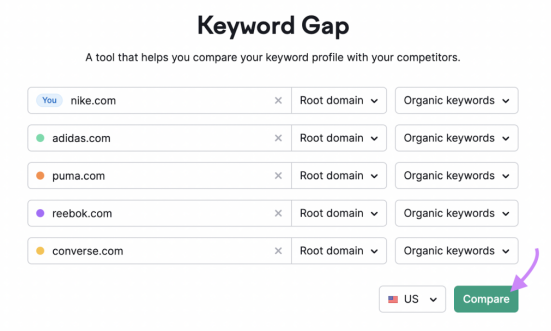
In the "Overview" report, scroll down to the table and select "Missing" to view the keywords your competitors are ranking for but you are not.
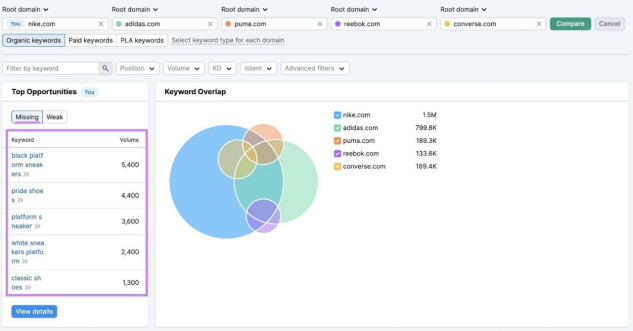
You can also filter by search intent, keyword difficulty, monthly search volume, and more to identify good keyword opportunities at each stage. By appearing in these searches, you can guide potential customers toward your solutions. Additionally, comparing your keywords with those of your competitors can uncover gaps and opportunities to refine your SEO strategy.
- SEO is a Scalable Growth Channel
SEO is one of the few truly scalable customer acquisition channels. Think of SEO as a continuous cycle where your actions (creating content) drive outputs (rankings, traffic, and customer acquisition). The revenue generated from these efforts can be reinvested into creating more content, which in turn generates additional rankings, traffic, and customers. This concept is known as a growth loop.
Scalable channels tend to produce incremental outputs that you can reinvest back into the channel. For example, if you invest 100inpaidadvertisingandearn100inpaidadvertisingandearn150, you can reinvest the initial 100plustheincremental100plustheincremental50 back into the channel. This begins to compound.
The same applies to SEO, but with an added benefit: when you stop investing, the returns often continue (at least for a while, until algorithm changes or competitive factors come into play).
- SEO Best Practices Enhance Your Overall Marketing Performance
SEO best practices—such as excellent website user experience, high-quality content, and alignment with search intent—can significantly improve your overall marketing performance.
Even if you’ve just created a website with great user experience and plenty of useful content, it will be beneficial even if you’re not yet driving organic traffic from search results. High-quality content can boost conversion rates and lead to more sales, regardless of where the traffic comes from.
8. SEO Reflects Changes in Consumer Behavior
Optimizing search means you’ll stay ahead of trends and shifts in consumer behavior. When done correctly, keyword research can reveal both rising and declining trends. For instance, according to Google Trends, the ketogenic (keto) diet appears to have peaked a few years ago and has been steadily declining since 2019, with occasional spikes around New Year’s.
By analyzing these trends, businesses can adapt their strategies to align with evolving consumer interests. SEO not only helps in identifying these changes but also enables brands to capitalize on emerging opportunities while avoiding outdated or declining trends. This proactive approach ensures that marketing efforts remain relevant and effective in capturing consumer attention.
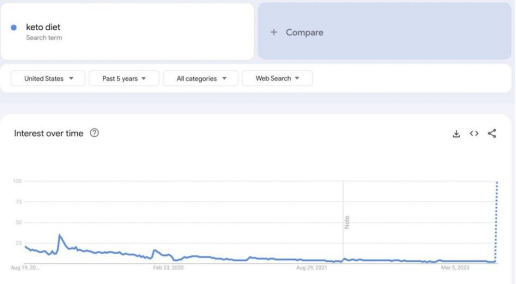
Or consider the rising trend that barely existed a few years ago: generative AI.
Take a look at how this term has recently surged in popularity:
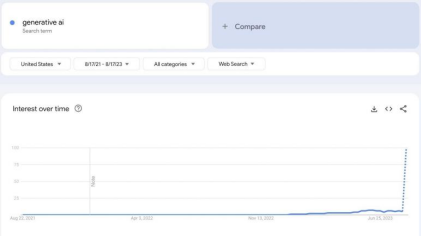
SEO is at the Forefront of Consumer Trends
- SEO Results Are Quantifiable
SEO results are easy to measure, allowing you to evaluate your performance and determine if adjustments are needed.
Using Google Analytics or alternative website analytics platforms, you can track organic traffic in relation to other channels.
You can attribute conversions to SEO efforts, even down to specific pages or blog posts.
Additionally, you can use rank-tracking tools to monitor keyword rankings and their changes over time. To get started, click the “+ Create Project” button, enter your domain, and then click “Create Project.” This enables you to track your SEO progress and make data-driven decisions for optimization.

Follow our setup instructions to configure your project, then click “Start Tracking.”
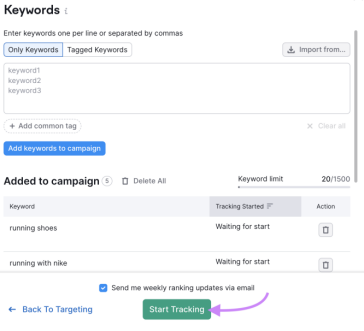
This displays your overall visibility in search results, the estimated traffic from those rankings, and your average ranking (along with changes over time).
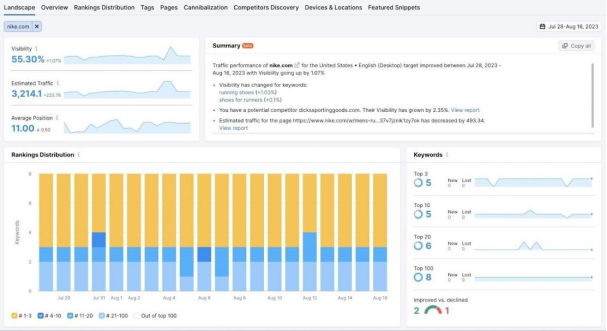
Click the "Overview" tab to view a detailed list of rankings for specific keywords and how they have changed over time.
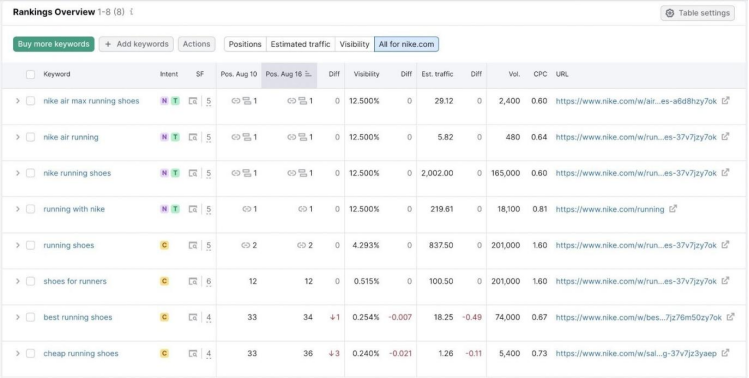
10. SEO Keeps Your Competitive Edge
Maintaining a competitive edge in search results is essential, and SEO is the key to achieving this. If your competitors are ranking for relevant search terms while you are not, you are missing out on valuable opportunities.
To identify these gaps, you can use keyword gap analysis tools. Simply input your domain along with up to four competitor domains, then click “Compare.” This will reveal the keywords your competitors are ranking for but you are not, allowing you to optimize your strategy and close the gap
29
36
.
By leveraging SEO and continuously monitoring competitor performance, you can ensure that your business stays ahead in the competitive landscape. This proactive approach helps you capture more organic traffic, improve visibility, and ultimately outperform your competitors.

向下滚动到“所有关键字详细信息:”并确保选择您的域名。
然后,单击“缺失”选项卡以查找所有竞争对手都排名但您没有排名的关键字。
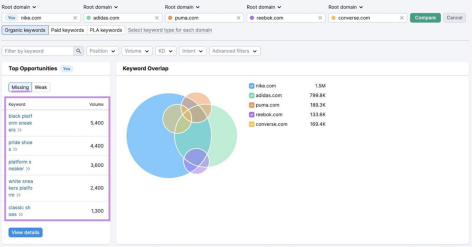
This can help you identify new topics to create content and maintain visibility in your industry.
What Are the Main Objectives of SEO?
While each SEO campaign can have unique goals, most online publishers aim to achieve some or all of the following five outcomes through their optimization efforts:
1. Increased Visibility in SERPs
Most Google users stay on the first page of search results to find answers to their queries, with 75% of users clicking on the first or second result. Due to this behavior, a primary goal of SEO is to rank higher in more search results. The more visible your content, the greater the chance of being discovered and chosen by the public. At this stage of learning, it’s important to note that website owners should not chase the myth of ranking first, as entities like Google display different results based on user location, device, or even subtle differences in query language. A better goal than ranking first is to achieve high visibility for your target audience across multiple SERP features and styles.
2. Increased Traffic to Your Website and Other Assets
When searchers reach your website by clicking on organic SERPs, it’s referred to as “traffic.” Whether the click-through rate (CTR) of your website pages in SERPs affects Google’s organic rankings remains a contentious issue in the SEO industry. Bing has confirmed that they use CTR and bounce rate (how quickly people leave your page after landing on it) as ranking factors. However, while the precise details of search engine algorithms remain confidential, the goal of SEO efforts is to drive more traffic from SERPs to your online assets.
3. Higher-Quality Traffic for Your Website
While any website would love to win significant traffic from SERPs, this traffic only impacts core business goals if it converts into sales or other key actions. For example, an independently owned donut shop in San Francisco might rank on the first page of Google for “yeast donuts.” It might go viral on social media due to an interesting or unusual marketing campaign and even make mainstream news. While it could gain national or even international traffic from these rankings and efforts, most of this traffic wouldn’t convert into sales since its products are only available to local customers. Therefore, a better goal than simply aiming for high traffic is using SEO to strategize how to attract the most qualified traffic for your offerings, as this typically has the highest conversion rates. High-quality organic traffic depends on search engines determining that your content is highly relevant to the queries most likely to drive conversions, whether defined as sales, form submissions, calls, leads, or even increased time spent on your website.
4. Improved Public Understanding
One of the best things you can do when learning SEO is to understand it as a form of customer service. Google rewards content that is useful to the public. In fact, their 2022 Helpful Content Update focused on how to reward websites that consistently publish content truly helpful to searchers. For decades, Google has urged website owners to create content for people, not search engines. SEO can make your website easier to understand, discover, and use for potential visitors. Optimization affects how your content appears in SERPs and how it looks and behaves when searchers click on your digital assets. Providing good service to the public and a great user experience is one of the most practical reasons to invest in SEO.
5. Improved Search Engine Understanding
For search engines to recommend and reward your content, enabling you to achieve the visibility, traffic, and conversions you desire, your website and other assets need to be understandable to crawlers/spiders/bots used by entities like Google and Bing to crawl and index digital content. This is achieved through various SEO efforts, which can be categorized into:
- On-Page SEO: Focuses on optimizing specific elements of website pages to make their content relevance clear.
- Technical SEO: Involves managing the technical backend of a website so search engines can efficiently crawl, index, and understand it.
- Off-Page SEO: Involves gaining links, citations, mentions, and news from third parties to build the authority of your digital assets.
Overall, these three areas of SEO work to ensure search engines can match your content with the perceived intent of searchers’ queries. The better search engines understand your content, the greater your chances of achieving high, broad, and high-converting rankings.
What SEO Factors Affect Search Engines?
Optimizing your website typically involves three key focus areas: on-page, off-page, and technical SEO.
- On-Page SEO: The practice of optimizing website content so that both search engines and humans can easily digest it.
- Technical SEO: Any well-executed technical action taken to improve search results, often by making your website run efficiently.
- Off-Page SEO: Actions taken outside your website that influence your rankings .

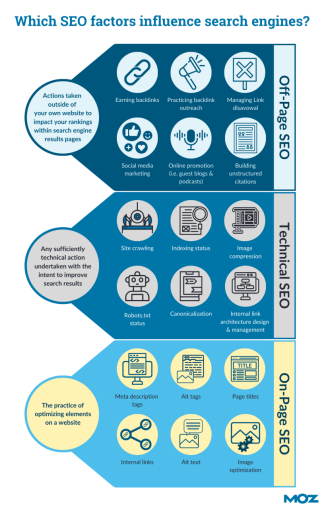
On-Page SEO
Investing in SEO involves engaging in customer research, market research, and keyword research so that your content reflects the actual language people use to search for what your website offers. The findings from your research can then be incorporated into optimizing multiple elements of your website and its pages, including but not limited to: domain names, page URLs, page titles, alt text, images, videos, navigation, meta description tags, internal links, and sitemaps.
Technical SEO
To ensure your website is correctly indexed and crawled by search engines and properly used by people, technical SEO includes but is not limited to managing the following elements: analytics setup, website crawling, indexing status, robots.txt status, canonicalization, internal linking architecture design and management, coding, mobile-friendliness, cross-browser rendering, page status codes, image compression, page load/speed optimization, structured data, JavaScript frameworks/rendering/pre-rendering, hreflang, de-indexing, and migrations.
Off-Page SEO
To ensure your digital assets achieve maximum visibility in search engines, meet your relevant traffic goals, and drive the conversions you seek, off-page SEO can essentially be defined as the practice of drawing attention to your content. Your options for achieving this include but are not limited to:
- Earning links and citations from high-quality third-party websites through the merit of your content.
- Managing link disavowals.
- Proactively building links and citations from high-quality third-party websites through outreach to these publications.
- Engaging in various forms of online promotion, including social media marketing and guest appearances on third-party blogs, podcasts, and vlogs.
- Traditional PR, including writing press releases and building relationships with influencers.
- For local businesses, creating local business profiles and building local unstructured citations.
For a complete tutorial on off-page SEO, read: Off-Page SEO. If you’re optimizing a local business website, read the Essential Local SEO Strategy Guide.
All the above factors collectively influence how search engines understand and rank your website pages. Together, they form a solid foundation that enables you to reach your target audience.
Truths About SEO
This is what SEO means in practice. However, before embarking on your SEO journey, keep these seven truths in mind:
- SEO is not about tricking Google. Instead, think of it as persuading Google to rank your pages by demonstrating the value you provide to users.
- SEO is not about hacks. Don’t get caught in the cycle of searching for cool new SEO tricks or hacks. Often, all you need is to consistently master the SEO basics.
- SEO is a long-term game. SEO results usually don’t appear immediately, though there are exceptions—for example, when you fix critical issues. Generally, think in terms of months, not days.
- SEO is more than just installing an SEO plugin. SEO plugins are useful tools, but simply setting one up doesn’t suddenly make your site “SEO-friendly.”
- SEO is never “done.” Search engine optimization is an ongoing process. Even if all your keywords rank first, you’ll always need to keep improving. The competition never stops.
- Understanding your audience is key. The more you understand your target audience (customers, readers, subscribers), the easier it is to craft an effective SEO strategy.
- SEO is only part of the puzzle. If you neglect the core of your business (your product or service), no amount of optimization will help.
Conclusion
SEO is an indispensable part of digital marketing. Its role extends beyond improving website search engine rankings to enhancing user experience, building brand trust and credibility, and driving high-quality traffic, thereby achieving long-term business goals and brand value. Through continuous optimization and data-driven decision-making, SEO can deliver significant and lasting benefits for businesses.
八、FAQ
Commonly Used SEO Tools
- Google Analytics: A free tool for tracking website traffic, user behavior, and other key metrics.
- Google Search Console: Helps website administrators monitor their site's performance in Google search results, providing insights into indexing status, search traffic, and website errors.
- SEMrush: A comprehensive SEO tool offering keyword research, competitor analysis, rank tracking, and more.
- Moz Pro: Provides similar functionalities to SEMrush, including keyword research, rank tracking, and website audits.
- Ahrefs: Primarily used for keyword research, backlink analysis, and rank tracking.
- Screaming Frog SEO Spider: A website auditing tool that checks meta tags, link structures, and other critical SEO factors.
How Long Does It Take to See Results from SEO?
SEO results often take time to materialize, and the timeframe can vary depending on several factors, including the current state of the website, the competitiveness of the targeted keywords, content quality, competitors, and more. Generally, it may take several months or even longer to see noticeable results from SEO efforts.
Here are some key factors that influence the time it takes to see SEO results:
-
Website Status: If a website has never undergone SEO optimization or has technical issues or low-quality content, it may take longer to address these problems and see improvements.
-
Keyword Competition: If the chosen keywords are highly competitive, it may take longer to achieve higher rankings.
-
Content Quality: High-quality, original content is more likely to gain search engine recognition and improve rankings, but building relevance and authority takes time.
-
External Links: Acquiring high-quality backlinks is a critical factor in improving rankings, but building these links typically requires time and consistent effort.
-
Competitors: The SEO strategies and performance of competitors can also impact your rankings. If competitors are actively optimizing, it may take more time to surpass them.
-
SEO Strategy: The effectiveness and efficiency of the SEO strategy implemented also play a role. A well-planned and executed strategy can yield faster results.
In summary, SEO results typically become noticeable within several months to a year. However, it’s important to note that SEO is an ongoing process. Once desired rankings and traffic are achieved, continuous optimization and maintenance are necessary to remain competitive.
How Often Do Search Engines Update Their Algorithms Affecting SEO?
Google's search engine does not follow a fixed schedule for updates but continuously evolves. Google uses a web crawler called Googlebot to regularly crawl and index web pages. The frequency of crawling and indexing depends on several factors, including how often a website is updated, its importance, and changes in Google's algorithms.
Generally, a standard website may be crawled every few days to weeks, while more important or frequently updated sites may be crawled more often. Additionally, Google's algorithms are constantly updated and refined, which can impact search result rankings and display methods.
To stay ahead, website administrators should monitor industry news, analyze website data, and adapt their SEO strategies to align with the latest algorithm changes.


